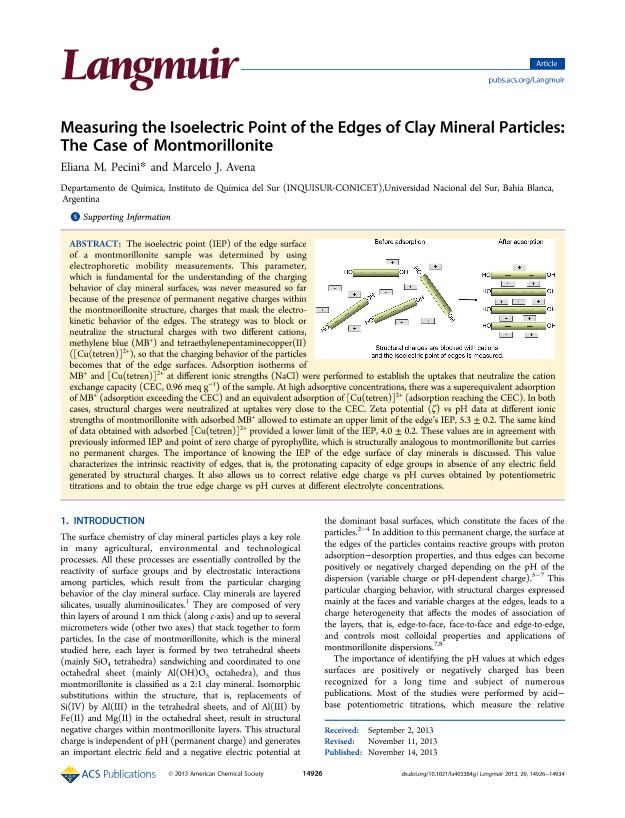Mostrar el registro sencillo del ítem
dc.contributor.author
Pecini, Eliana Melisa
dc.contributor.author
Avena, Marcelo Javier

dc.date.available
2016-04-27T15:46:49Z
dc.date.issued
2013-11
dc.identifier.citation
Pecini, Eliana Melisa; Avena, Marcelo Javier; Measuring the isoelectric point of the edges of clay mineral particles. The case of montmorillonite; American Chemical Society; Langmuir; 29; 11-2013; 14926-14934
dc.identifier.issn
0743-7463
dc.identifier.uri
http://hdl.handle.net/11336/5415
dc.description.abstract
The isoelectric point (IEP) of the edge surface of a montmorillonite sample was determined by using electrophoretic mobility measurements. This parameter, which is fundamental for the understanding of the charging behavior of clay mineral surfaces, was never measured so far because of the presence of permanent negative charges within the montmorillonite structure, charges that mask the electro- kinetic behavior of the edges. The strategy was to block or neutralize the structural charges with two di ff erent cations, methylene blue (MB + ) and tetraethylenepentaminecopper(II) ([Cu(tetren)] 2+ ), so that the charging behavior of the particles becomes that of the edge surfaces. Adsorption isotherms of MB + and [Cu(tetren)] 2+ at di ff erent ionic strengths (NaCl) were performed to establish the uptakes that neutralize the cation exchange capacity (CEC, 0.96 meq g − 1 ) of the sample. At high adsorptive concentrations, there was a superequivalent adsorption of MB + (adsorption exceeding the CEC) and an equivalent adsorption of [Cu(tetren)] 2+ (adsorption reaching the CEC). In both cases, structural charges were neutralized at uptakes very close to the CEC. Zeta potential ( ζ ) vs pH data at di ff erent ionic strengths of montmorillonite with adsorbed MB + allowed to estimate an upper limit of the edge ? s IEP, 5.3 ± 0.2. The same kind of data obtained with adsorbed [Cu(tetren)] 2+ provided a lower limit of the IEP, 4.0 ± 0.2. These values are in agreement with previously informed IEP and point of zero charge of pyrophyllite, which is structurally analogous to montmorillonite but carries no permanent charges. The importance of knowing the IEP of the edge surface of clay minerals is discussed. This value characterizes the intrinsic reactivity of edges, that is, the protonating capacity of edge groups in absence of any electric fi eld generated by structural charges. It also allows us to correct relative edge charge vs pH curves obtained by potentiometric titrations and to obtain the true edge charge vs pH curves at di ff erent electrolyte concentrations.
dc.format
application/pdf
dc.language.iso
eng
dc.publisher
American Chemical Society

dc.rights
info:eu-repo/semantics/openAccess
dc.rights.uri
https://creativecommons.org/licenses/by-nc-sa/2.5/ar/
dc.subject
Electrophoresis
dc.subject
Pzc
dc.subject.classification
Físico-Química, Ciencia de los Polímeros, Electroquímica

dc.subject.classification
Ciencias Químicas

dc.subject.classification
CIENCIAS NATURALES Y EXACTAS

dc.title
Measuring the isoelectric point of the edges of clay mineral particles. The case of montmorillonite
dc.type
info:eu-repo/semantics/article
dc.type
info:ar-repo/semantics/artículo
dc.type
info:eu-repo/semantics/publishedVersion
dc.date.updated
2016-05-06 15:52:43.262787-03
dc.journal.volume
29
dc.journal.pagination
14926-14934
dc.journal.pais
Estados Unidos

dc.journal.ciudad
Washington
dc.description.fil
Fil: Pecini, Eliana Melisa. Consejo Nacional de Investigaciones Científicas y Técnicas. Centro Científico Tecnológico Bahía Blanca. Instituto de Química del Sur; Argentina. Universidad Nacional del Sur; Argentina
dc.description.fil
Fil: Avena, Marcelo Javier. Consejo Nacional de Investigaciones Científicas y Técnicas. Centro Científico Tecnológico Bahía Blanca. Instituto de Química del Sur; Argentina. Universidad Nacional del Sur; Argentina
dc.journal.title
Langmuir

dc.relation.alternativeid
info:eu-repo/semantics/altIdentifier/url/http://pubs.acs.org/doi/abs/10.1021/la403384g
dc.relation.alternativeid
info:eu-repo/semantics/altIdentifier/doi/10.1021/la403384g
dc.relation.alternativeid
info:eu-repo/semantics/altIdentifier/doi/http://dx.doi.org/10.1021/la403384g
Archivos asociados
